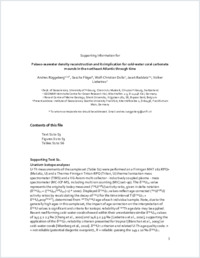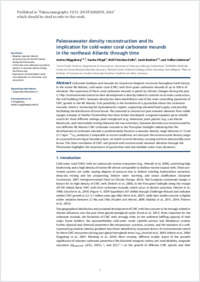Paleoseawater density reconstruction and its implication for cold-water coral carbonate mounds in the northeast Atlantic through time
- Rüggeberg, Andres Unit of Earth Sciences, Department of Geosciences, University of Fribourg, Switzerland - GEOMAR Helmholtz Centre for Ocean Research Kiel, Germany - Renard Centre of Marine Geology, Ghent University, Gent, Belgium
- Flögel, Sascha GEOMAR Helmholtz Centre for Ocean Research Kiel, Germany
- Dullo, Wolf-Christian GEOMAR Helmholtz Centre for Ocean Research Kiel, Germany
- Raddatz, Jacek GEOMAR Helmholtz Centre for Ocean Research Kiel, Germany - Institute of Geosciences, Goethe University Frankfurt, Germany
- Liebetrau, Volker GEOMAR Helmholtz Centre for Ocean Research Kiel, Germany
-
01.03.2016
Published in:
- Paleoceanography. - 2016, vol. 31, no. 3, p. 2015PA002859
English
Carbonate buildups and mounds are impressive biogenic structures throughout Earth history. In the recent NE Atlantic, cold-water coral (CWC) reefs form giant carbonate mounds of up to 300 m of elevation. The expansion of these coral carbonate mounds is paced by climatic changes during the past 2.7 Myr. Environmental control on their development is directly linked to controls on its main constructors, the reef-building CWCs. Seawater density has been identified as one of the main controlling parameter of CWC growth in the NE Atlantic. One possibility is the formation of a pycnocline above the carbonate mounds, which is increasing the hydrodynamic regime, supporting elevated food supply, and possibly facilitating the distribution of coral larvae. The potential to reconstruct past seawater densities from stable oxygen isotopes of benthic foraminifera has been further developed: a regional equation gives reliable results for three different settings, peak interglacials (e.g., Holocene), peak glacials (e.g., Last Glacial Maximum), and intermediate setting (between the two extremes). Seawater densities are reconstructed for two different NE Atlantic CWC carbonate mounds in the Porcupine Seabight indicating that the development of carbonate mounds is predominantly found at a seawater density range between 27.3 and 27.7 kg m⁻³ (σΘ notation). Comparable to recent conditions, we interpret the reconstructed density range as a pycnocline serving as boundary layer, on which currents develop, carrying nutrition and possibly coral larvae. The close correlation of CWC reef growth with reconstructed seawater densities through the Pleistocene highlights the importance of pycnoclines and intermediate water mass dynamics.
- Faculty
- Faculté des sciences et de médecine
- Department
- Département de Géosciences
- Language
-
- English
- Classification
- Geology
- License
- License undefined
- Identifiers
-
- RERO DOC 277691
- DOI 10.1002/2015PA002859
- Persistent URL
- https://folia.unifr.ch/unifr/documents/305116
Other files
Statistics
Document views: 70
File downloads:
- rug_pdr_sm.pdf: 140
- rug_pdr.pdf: 131

